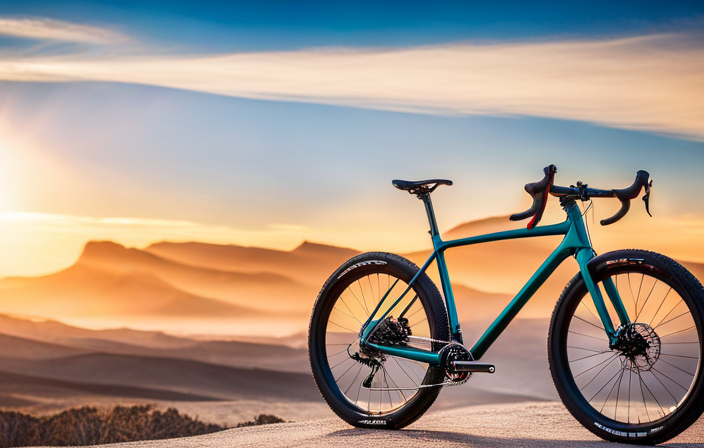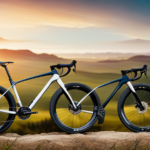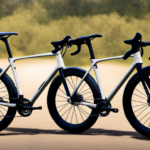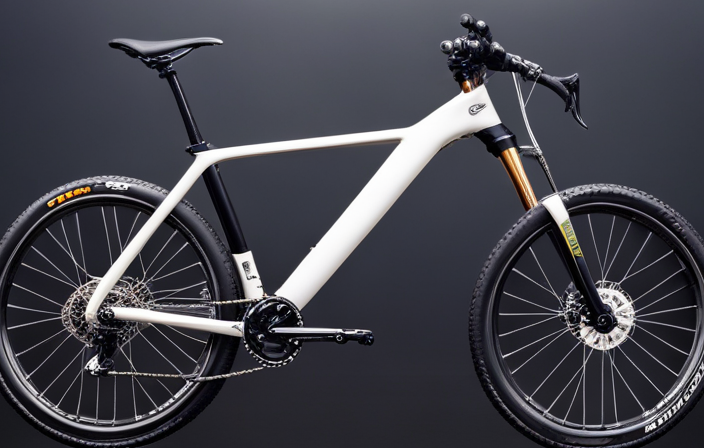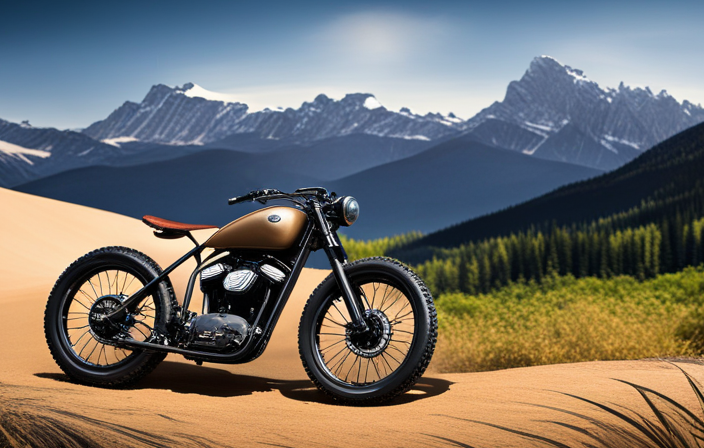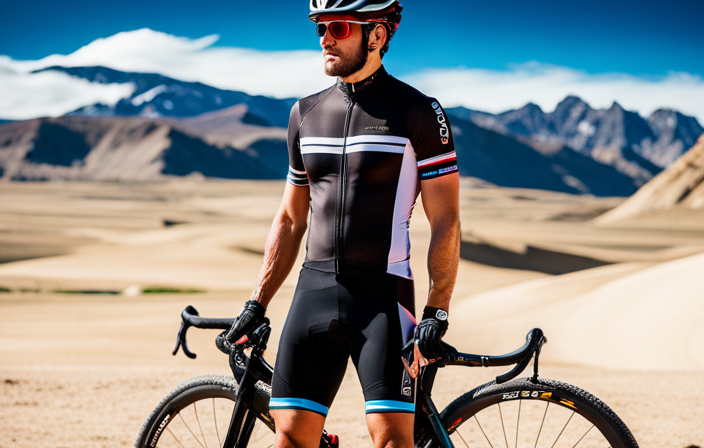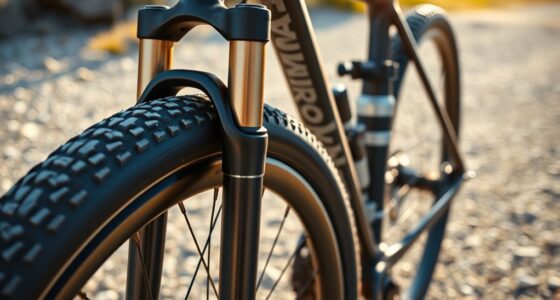Picture yourself soaring through the rural landscape, feeling the breeze in your hair and the excitement of exploring in your blood. Experience the joy of rural exploration firsthand – it’s an adventure unlike any other that will leave you feeling invigorated and alive!
As a passionate cyclist, I’ve discovered that there’s one type of bike that perfectly captures this sense of freedom and exploration: the gravel bike.
With its versatility, off-road capabilities, and comfortable geometry, a gravel bike is like having a trusty steed that can conquer any terrain.
In this article, we’ll delve into what distinguishes a gravel bike and why it’s becoming increasingly popular among cyclists.
Key Takeaways
- Gravel bikes are designed for off-road adventures and offer versatility and adaptability.
- They prioritize comfort and performance with features like wider tires, adjustable handlebar positions, and comfortable saddle options.
- Gravel bikes are durable and constructed with sturdy frames made from aluminum or carbon fiber, and they feature wider tires and disc brakes for reliable stopping power.
- They are ideal for exploration and adventure, with additional storage options for bikepacking and various mounting points for attaching bags, racks, and accessories securely.
Versatility and Adaptability
One thing that really sets a gravel bike apart is its versatility and adaptability. These bikes are designed to handle various terrains and weather conditions, making them the perfect choice for riders who enjoy off-road adventures.
One of the key features that contribute to their adaptability is the tire size. Gravel bikes typically come with wider tires compared to road bikes, which allows for better traction on different surfaces such as gravel, dirt, or even mud. This makes it easier to navigate through challenging terrains without sacrificing speed or stability.
Moreover, gravel bikes offer customization options for personal preferences. Riders can choose different components such as handlebars, saddles, and gears based on their riding style and comfort level. This not only enhances the overall riding experience but also ensures that each rider can customize their bike according to their specific needs.
In terms of adaptability in different weather conditions, gravel bikes excel due to their durable construction and frame design. They are built to withstand harsh environments and adverse weather conditions such as rain or snow. Additionally, many gravel bikes come equipped with disc brakes which provide reliable stopping power even in wet or muddy conditions.
With their versatility and adaptability in mind, it’s clear that gravel bikes are specifically designed for off-road adventures without compromising performance or comfort.
Designed for Off-Road Adventures
For off-road adventures, a gravel bike is specifically designed to handle rough terrain and provide a comfortable ride. It has four key features that make it perfect for tackling off-road challenges and gravel racing.
-
Robust Frame: Gravel bikes are built with sturdy frames made from materials like aluminum or carbon fiber. These frames are designed to withstand the rigors of off-road riding, absorbing vibrations and providing stability on uneven surfaces.
-
Wider Tires: Unlike road bikes, gravel bikes come equipped with wider tires that offer increased traction and grip on loose or muddy trails. The larger tire volume also helps to absorb shocks and reduces the risk of punctures when navigating rough terrain.
-
Disc Brakes: To ensure reliable stopping power in all conditions, gravel bikes feature disc brakes. These hydraulic or mechanical systems provide precise control over braking force, allowing riders to confidently navigate steep descents or sudden obstacles.
-
Versatile Gearing: Gravel bikes often have a wide range of gears to tackle varying terrains encountered during off-road adventures. This allows riders to effortlessly conquer steep climbs or maintain speed on flat sections.
With its rugged frame, wider tires, powerful brakes, and versatile gearing system, a gravel bike is well-suited for off-road challenges and even gravel racing events.
However, these characteristics also make it suitable for long-distance riding where comfort and durability are essential factors.
Suitable for Long-Distance Riding
If you’re looking to embark on long-distance rides, you’ll appreciate how a gravel bike is built for endurance and comfort. Designed with bikepacking essentials in mind, these bikes are equipped with features that make them suitable for the rigors of long-distance riding.
One key aspect of a gravel bike that enhances its suitability for long rides is its geometry. The frame geometry of a gravel bike strikes a balance between stability and agility, allowing riders to maintain control over varied terrain while still being able to cover long distances efficiently. Additionally, the relaxed head tube angle and longer wheelbase contribute to increased stability during extended rides.
To further enhance comfort during long-distance rides, gravel bikes often feature wider tires compared to traditional road bikes. These wider tires provide enhanced stability and traction on rough surfaces, making them ideal for off-road adventures or unpaved roads commonly encountered during long rides.
When it comes to training strategies for long-distance riding, gravel bikes offer versatility. They can handle various terrains and can be fitted with accessories such as racks or panniers to carry all the necessary gear for multi-day trips.
By incorporating these design elements into their construction, gravel bikes are well-suited for those seeking endurance and comfort on their long-distance journeys. With their ability to handle different terrains and accommodate bikepacking essentials, they provide an optimal platform for unforgettable adventures.
Wider Tires for Enhanced Stability
To enhance your stability while riding long distances, you’ll appreciate the wider tires on a gravel bike. The wider tire benefits are numerous and can greatly improve your overall riding experience. Here are three key advantages of having wider tires:
-
Increased traction: Wider tires provide a larger contact patch with the ground, allowing for better grip on various surfaces like gravel, dirt, or even wet roads. This enhanced traction gives you more confidence while cornering and braking, especially when encountering loose or uneven terrain.
-
Improved stability: The wider profile of gravel bike tires creates a more stable platform, reducing the chances of losing balance or skidding during high-speed descents or tight turns. This extra stability is particularly crucial when navigating unpredictable off-road terrains where maintaining control is essential.
-
Enhanced comfort: With wider tires comes increased cushioning and shock absorption capabilities. They effectively dampen vibrations caused by rough surfaces, ensuring a smoother ride even over bumpy terrain. This added comfort translates to reduced fatigue during long-distance rides, allowing you to stay in the saddle for longer periods without discomfort.
When it comes to tire pressure recommendations for gravel bikes with wider tires, it is important to strike a balance between grip and efficiency. Generally, lower tire pressures around 30-50 psi (pounds per square inch) are recommended for off-road adventures to maximize traction and absorb shocks effectively.
With the enhanced stability provided by wider tires covered in detail above, let’s now explore another crucial aspect of what distinguishes a gravel bike – its comfortable geometry for a smooth ride…
Comfortable Geometry for a Smooth Ride
The comfortable geometry of a gravel bike ensures a smooth ride for cyclists. One key element of this comfortable geometry is the availability of different saddle options. Gravel bikes are designed with long rides in mind, so manufacturers offer a range of saddle choices to accommodate different body types and preferences.
Some riders prefer wider saddles with extra padding for added comfort, while others may opt for narrow saddles that provide more freedom of movement. Additionally, gravel bikes typically have adjustable handlebar positions, allowing riders to find the most comfortable riding position for their body and riding style. This adjustability helps prevent discomfort and fatigue during long rides by reducing strain on the wrists, shoulders, and back.
By incorporating these comfortable features into the design of gravel bikes, cyclists can enjoy a smooth and enjoyable ride even on rough terrain. The increased clearance provided by these bikes allows them to tackle uneven surfaces without compromising stability or control. With their wider tires, comfortable saddle options, and adjustable handlebar positions, gravel bikes are specifically engineered to provide both comfort and performance on any type of terrain.
Now let’s explore how increased clearance enhances a gravel bike’s ability to navigate rough terrain.
Increased Clearance for Rough Terrain
When it comes to gravel bikes, one of the key features that distinguishes them from other types of bicycles is their comfortable geometry. This allows for a smooth and enjoyable ride, even on longer distances or rough terrains.
Another important factor that sets gravel bikes apart is their increased clearance for rough terrain. Gravel bikes are designed with larger tire clearances compared to road or mountain bikes. This means that they can accommodate wider tires, providing increased stability and improved traction on uneven surfaces such as gravel roads or dirt trails. The extra clearance also prevents mud and debris from getting stuck in the frame or tires, ensuring a more efficient ride.
With this increased stability and improved traction, riders can confidently tackle challenging terrains without compromising speed or control. Whether it’s navigating through loose gravel or powering through muddy sections, a gravel bike’s design allows for optimal performance in various conditions.
In conclusion, the increased clearance of a gravel bike enables riders to explore new off-road adventures with confidence and ease. Now let’s dive into the next section about durable construction for endurance…
Durable Construction for Endurance
With durable construction built to endure, you can confidently conquer long rides on rough terrain with ease. The durability benefits of a gravel bike are crucial for riders who want to push their limits and explore off-road trails. These bikes are designed to withstand the harsh conditions encountered during endurance rides, ensuring that they remain reliable and sturdy throughout the journey.
One key aspect of a gravel bike’s durable construction is the choice of materials used. Manufacturers often opt for high-quality alloys or carbon fiber frames that offer both strength and lightness. These materials are specifically chosen for their ability to absorb shocks and vibrations, minimizing fatigue on longer rides. Additionally, components such as wheels and drivetrain parts are made from sturdy materials like aluminum or steel to withstand the rigors of rough terrain.
The use of robust construction materials ensures that gravel bikes can handle the demands placed upon them during endurance rides on unpredictable surfaces. Whether it’s navigating through rocky trails or tackling uneven terrain, these bikes provide riders with confidence in their ability to withstand whatever challenges lie ahead.
Transitioning into the next section about disc brakes for reliable stopping power… As important as durable construction is, having reliable stopping power is equally essential when riding on rough terrain.
Disc Brakes for Reliable Stopping Power
Get the confidence you need to ride on rough terrain with disc brakes, providing reliable stopping power. Disc brakes are a key feature that distinguishes gravel bikes from other types of bicycles. They offer improved safety and reliable braking performance, allowing riders to navigate challenging off-road conditions with ease.
When it comes to disc brakes, there are two main types: mechanical and hydraulic. Mechanical disc brakes use cables to activate the brake calipers, while hydraulic disc brakes rely on fluid pressure for braking power. Both options have their advantages and disadvantages.
-
Mechanical Disc Brakes:
-
Easy maintenance: With a simple cable system, mechanical disc brakes are easier to adjust and maintain.
-
Less expensive: Mechanical disc brakes tend to be more affordable compared to their hydraulic counterparts.
-
Hydraulic Disc Brakes:
-
Enhanced stopping power: Hydraulic systems provide greater braking force, resulting in shorter stopping distances.
-
Consistent performance: Hydraulic disc brakes deliver consistent braking performance in various weather conditions.
The reliable braking performance offered by disc brakes is especially crucial when riding on unpredictable gravel surfaces. It provides riders with the confidence they need to tackle steep descents or sudden obstacles without compromising safety.
With the knowledge of how important reliable stopping power is for gravel riding, let’s now explore another distinguishing feature of gravel bikes – mounting points for bikepacking gear.
Mounting Points for Bikepacking Gear
When it comes to gravel bikes, there are several key features that set them apart from other types of bicycles. In my previous discussion on disc brakes, I highlighted how they provide reliable stopping power in all weather conditions. Now, let’s delve into another important aspect of gravel bikes: their mounting points for bikepacking gear.
Gravel bikes are designed with bikepacking in mind, which involves carrying all the necessary equipment for multi-day adventures. To accommodate this, manufacturers have incorporated various mounting solutions onto the frame and fork of gravel bikes. These mounting points allow riders to attach bags, racks, and other accessories securely.
To give you a better understanding of these mounting options, take a look at the table below:
| Mounting Point | Location |
|---|---|
| Frame mounts | Located on the top tube or down tube |
| Fork mounts | Positioned on the fork legs or crown |
| Seatpost mounts | Found on the seat tube or seatpost itself |
| Rear rack mounts | Situated near the rear dropouts |
These well-thought-out mounting solutions make it easier than ever to carry your camping gear, clothing, and supplies while exploring remote areas. With a gravel bike’s bikepacking gear compatibility, you can embark on epic journeys without worrying about storage limitations.
Now that we’ve covered the importance of mounting points for bikepacking gear, let’s move on to discussing how gravel bikes excel at handling various terrains.
Ability to Handle Various Terrains
Gravel bikes are versatile and can easily handle a wide range of terrains. Whether you’re riding on smooth pavement, tackling gravel roads, or even venturing onto dirt trails, a gravel bike is designed to excel in all these conditions. Here are four reasons why gravel bikes are so capable:
-
Wider Tires: Gravel bikes typically have wider tires compared to road bikes, providing better traction and stability on uneven surfaces. These tires also offer added comfort during long rides over rough terrain.
-
Suspension: Some gravel bikes come equipped with front suspension forks or rear suspension systems, absorbing shocks and vibrations from the trail. This feature enhances control and comfort when encountering bumps or potholes.
-
Frame Geometry: Gravel bike frames often have a more relaxed geometry than road bikes, striking a balance between stability and agility. This design allows for confident handling on both paved roads and off-road paths.
-
Mounting Points: Gravel bikes usually come with numerous mounting points that allow you to attach bikepacking essentials and accessories such as racks, panniers, or frame bags. These additional storage options enable you to carry all the gear necessary for your adventures.
With their ability to handle various terrains, gravel bikes open up a world of possibilities for riders seeking exploration beyond traditional road cycling routes. Additionally, they are compatible with different wheel sizes…
Compatible with Different Wheel Sizes
You’ll find that these bikes are designed to be compatible with a variety of wheel sizes, allowing you to customize your ride based on your preferences and the type of terrain you plan to tackle. Gravel bikes typically come with the option of using either 700c or 650b wheels. The choice between these two sizes depends on factors such as personal preference, desired riding characteristics, and the specific demands of the terrain.
Different wheel sizes offer different benefits when it comes to gravel riding. The larger 700c wheels provide better rolling efficiency, making them ideal for smooth surfaces and high-speed riding. On the other hand, the smaller 650b wheels offer increased maneuverability and improved traction on rougher terrains. By having the ability to switch between these wheel sizes, you can optimize your bike’s performance for various conditions.
Additionally, tire pressure plays a crucial role in determining how well a gravel bike handles different terrains. Lower tire pressure provides better traction and comfort on loose or uneven surfaces, while higher tire pressure enhances speed and efficiency on smoother roads. With a gravel bike that is compatible with different wheel sizes, you can easily adjust your tire pressure to suit the specific terrain you’ll be encountering.
Transitioning into our next section about wide gear range for climbing and descending, it is important to consider how these varying wheel sizes contribute to overall performance on different types of trails and gradients without compromising control or stability.
Wide Gear Range for Climbing and Descending
The wide gear range allows for efficient climbing and descending on various terrains. Gravel bikes are designed to handle a wide range of riding conditions, from smooth pavement to rugged off-road trails. To achieve this versatility, gravel bikes are equipped with a wide variety of gear ratio options. This ensures that riders can find the perfect combination of gears for tackling steep climbs or powering through fast descents.
To illustrate the importance of gear ratio options, consider the following table:
| Gear Ratio | Climbing Capabilities |
|---|---|
| 1:1 | Steep inclines |
| 2:1 | Moderate inclines |
| 3:1 | Rolling hills |
| 4:1 | Fast descents |
| 5:1 | Flat terrain |
By having these gear ratios available, riders can conquer any type of terrain they encounter during their gravel adventures. The ability to shift into lower gears for steep climbs provides the necessary power and control, while higher gears allow for faster speeds on descents and flat sections.
With the wide gear range at your disposal, you can confidently tackle challenging climbs and thrilling descents on your gravel bike. Transitioning into the next section about suspension options for added comfort is essential in ensuring an enjoyable riding experience.
Suspension Options for Added Comfort
One option for added comfort on your ride is to consider the different suspension options available. Gravel bikes are designed to handle a variety of terrains, including rough and uneven surfaces. To ensure a smooth and comfortable ride, manufacturers offer various suspension types to absorb shocks and vibrations.
The most common suspension type found on gravel bikes is the front fork suspension. This type of suspension provides cushioning for the front wheel, allowing it to absorb impacts from bumps and rough roads. It enhances rider comfort by reducing fatigue and minimizing strain on the arms and upper body.
Another popular option is the full-suspension system, which includes both front fork suspension and rear shock absorption. This system offers even greater comfort by absorbing shocks from both wheels simultaneously. It provides improved traction, especially on challenging terrain like gravel or dirt trails.
The benefits of added comfort through suspension options cannot be overstated. Not only does it make long rides more enjoyable, but it also reduces the risk of injury caused by excessive vibration or impact forces.
In addition to considering suspension options for added comfort, another important aspect to look out for in a gravel bike is a lightweight frame that allows for easy maneuverability…
Lightweight Frame for Easy Maneuverability
To enhance your riding experience, prioritize a lightweight frame that offers easy maneuverability. A lightweight bike design is essential for agile maneuvering on gravel roads.
Here are four key features to look for in a lightweight frame:
-
Carbon Fiber Construction: Carbon fiber frames are incredibly lightweight and provide excellent strength and stiffness. They absorb vibrations well, ensuring a smooth ride without compromising control.
-
Tube Shapes and Butting: Manufacturers use various tube shapes and butting techniques to reduce weight while maintaining structural integrity. Look for bikes with carefully engineered tubes that maximize strength-to-weight ratio.
-
Compact Geometry: Gravel bikes often feature compact geometry, which means shorter top tubes and higher stack heights. This allows for a more upright riding position, making it easier to handle technical terrain and navigate tight corners.
-
Innovative Material Choices: Some brands experiment with alternative materials like titanium or high-strength aluminum alloys to create ultralight frames without sacrificing durability.
These features contribute to the overall performance of a gravel bike, allowing you to effortlessly maneuver through any gravel adventure.
The increasing popularity among cyclists can be attributed to the combination of these design elements that deliver an enjoyable riding experience in challenging conditions.
Increasing Popularity Among Cyclists
When considering a lightweight frame for easy maneuverability, you’ll notice the increasing popularity among cyclists. The gravel bike, with its ability to tackle various terrains and provide a comfortable ride, has seen an increased demand in recent years. This can be attributed to the growth of the cycling community and the desire for more versatile bikes.
Gravel biking has become a favorite among cyclists due to its versatility. These bikes are designed to handle both paved roads and off-road trails with ease. The lightweight frame plays a significant role in making these bikes agile and responsive, allowing riders to navigate through obstacles effortlessly.
The increased demand for gravel bikes can also be attributed to the growing popularity of bikepacking and adventure cycling. More cyclists are seeking new experiences beyond traditional road or mountain biking, opting for long-distance rides on mixed surfaces. Gravel bikes offer the perfect combination of speed, comfort, and stability needed for these adventures.
Furthermore, the cycling community itself has experienced significant growth in recent years. With more people embracing biking as a form of exercise, transportation, or recreation, there is an increased interest in finding versatile bikes that can handle different riding conditions.
In conclusion, when considering a lightweight frame for easy maneuverability in gravel biking, it’s evident that there is an increasing demand for these bikes within the cycling community. The growth of this sport and the desire for more adventurous experiences have led to the rising popularity of gravel bikes among cyclists worldwide.
Frequently Asked Questions
Can a gravel bike be used for commuting or urban riding?
Yes, a gravel bike can definitely be used for commuting or urban riding. It offers several benefits for daily commuting.
One benefit is its versatility on different terrains. A gravel bike can handle both pavement and gravel roads, making it suitable for various commuting routes.
Another benefit is the wider tires, which provide better stability and comfort. These tires can absorb bumps and vibrations, resulting in a smoother ride.
The relaxed geometry of a gravel bike ensures a comfortable riding position. This is important for longer commutes, as it reduces strain on the body and promotes better posture.
Additionally, gravel bikes are equipped with disc brakes, which offer reliable stopping power. This is particularly useful in urban terrain, where there may be unexpected obstacles or the need for sudden stops.
Overall, a gravel bike is an excellent choice for commuting in diverse urban environments. It combines versatility, comfort, and reliable performance, making it a practical and enjoyable option for daily rides.
Can I use a gravel bike for touring or bikepacking?
Using a gravel bike for long distance rides, such as touring or bikepacking, can be a great option. They offer versatility with their wider tires for tackling various terrains and the ability to carry luggage with racks and panniers.
The pros include their comfortable geometry, allowing for endurance on extended rides, and the ability to handle rough roads. However, it’s important to consider the cons too, such as decreased speed compared to road bikes and limited aerodynamics on smooth surfaces.
What types of terrain can a gravel bike handle?
A gravel bike is designed to handle a variety of terrains, making it a versatile option for riders.
Compared to a mountain bike, a gravel bike offers a more efficient and faster ride on smoother surfaces while still being capable of tackling rough gravel roads.
In comparison to a cyclocross bike, a gravel bike typically has more relaxed geometry, wider tires for better stability on loose terrain, and additional mounting points for racks and bags, making it suitable for longer rides and bikepacking adventures.
Are gravel bikes suitable for beginners or only experienced riders?
Gravel bikes are suitable for both beginners and experienced riders, but there are pros and cons to consider.
Beginners on gravel bikes can benefit from their versatility, as they handle various terrains with ease. However, these bikes may require some skill development due to their unique characteristics like wider tires and different riding position.
It’s essential for beginners to familiarize themselves with the bike’s handling and adjust to the off-road conditions before venturing into more challenging routes.
How does a gravel bike differ from a mountain bike or road bike?
A gravel bike differs from a mountain bike or road bike in several key ways.
First, let’s talk about the difference between a gravel bike and a cyclocross bike. While both are designed for off-road riding, gravel bikes have more relaxed geometry and wider tires, making them better suited for long-distance endurance rides on mixed surfaces.
Key features of a gravel bike include disc brakes for better stopping power, clearance for larger tires, and mounting points for racks and fenders.
Conclusion
So there you have it, folks. The gravel bike, the epitome of versatility and adaptability, designed to conquer the off-road adventures that most bikes dare not tread.
With its wider tires for enhanced stability and comfortable geometry for a smooth ride, this lightweight wonder is truly a force to be reckoned with.
And let’s not forget about the wide gear range and suspension options that add a touch of luxury to your cycling experience. It’s no wonder these bikes are gaining popularity among cyclists everywhere.
So hop on your trusty gravel steed and prepare yourself for an adventure like no other!
